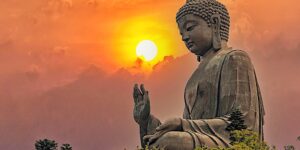The Great Cundī Dhāraṇī Sūtra and the Great Mother Cunda: Benefits, Commentary, and Complete Verses

The Heart of the Mother of Seven Koṭi Buddhas
The Sūtra of the Great Cundī Dhāraṇī, the Heart of the Mother of Seven Million Buddhas, is a teaching from Shakyamuni Buddha that expresses the compassionate essence of the Wisdom Mother Cundi.
Cundī — pronounced “Chundee” — also known as Cunda (Chundah) is none other than Wisdom and Compassion embodied. In a Drikung meditation manual, she is described this way:
“Cunda quickly ripens all spiritual powers;
She motivates Buddhas and Bodhisattvas to help living beings,
Induces beings to embark on the Buddhist Path, and
Inspires renouncers and solitary achievers to follow the Bodhisattva Way
Shakyamuni proclaimed that her mantras shake the Buddha-worlds,
Defeat all demons, and bestow many miraculous powers…
Through the recitation of her mantra,
All diseases are purified, and Buddhahood is quickly attained.
Even a tenth-level Bodhisattva does not surpass her in brilliance.
All worldly and spiritual perfections are attained through her mantra.” [1]

Shakyamuni Buddha taught the miraculous benefits of reciting the Cundi Dharaani and making offerings to the great Mother of Seven Million Buddhas.
Like all aspects of compassion, she can be considered also an emanation of Avalokiteshvara or Guanyin. She is sometimes called 18-Armed Guanyin Cundi.

Cundi Appearance: Four Arms and Eighteen
Like a the kind Bodhisattva mother, her face is serene and beautiful. She is visualized usually in two main forms, although there are others. She is of the colour of the autumn moon, and is four-armed. She shows the varada-mudrā in the right hand and holds the book on a lotus in the left. The two other hands hold the bowl. She can appear similar to the Mother Prajnaparamita, as they are both great Wisdom Mothers. You can always differentiate Chunda by her bowl or vase held in the two hands.

The four-armed form symbolizes the Four Immeasurables, iconic of a Great Wisdom Mother. These are: loving-kindness or benevolence, compassion, empathetic joy, and equanimity.
She also has a compassionate 18-armed form, where each hand holds implements representing her many skillful means. The many arms represent the eighteen merits of attaining Buddhahood, which is described in the appendix to the Cundi Dharani Sutra.

The less common forms are six, sixteen and twenty-six armed aspects. The many arms represent her skillful means, and her unlimited compassion, reaching out to benefit all sentient beings. There is also a less common three-faced 26-armed aspect, and others.
As with most compassionate aspects of Enlightenment, her offerings should always be vegetarian.

The Miraculous Benefits of Reciting the Cundī Dhāraṇī Sūtra
As a Sutra mantra the benefits are profound and the only transmission required is that of reading the Sutra — ideally out loud. Unlike lineage-based mantras, which benefit from the lineage blessings of a long line of enlightened teachers, Sutra mantras and Dharanis are direct from Shakyamuni Gautama Buddha.
The benefits of recitation and reliance on the Chundi Dharani and mantra is described in the Sutra, and include purification of all negative karma, healing of disease, bringing prosperity or well-being, auspicious rebirth, protection and more. What does this really mean? It means reciting and meditation is “good for you”, a mental “workout” and, like “exercise” for the body should be practiced daily for well-being.

From a lay person point of view, the benefits are expressed by Buddha in the Sutra:
“If there are good laymen and laywomen who keep reciting this Dharani, their homes will not be ravaged by catastrophes or diseases. Their work will be smooth and harmonious, and others will believe and accept what they say.”

Her mantra is short and easy to remember and pronounce. It is simply (c pronounced as “ch”):
oṃ cale cule cunde svāhā
Or, you can recite it as as the full Dharani with mantra, which includes her praise. If you recite the praise, it generally translates into English as: Homage to the Mother of Seven Million Buddhas, thus (or like this): followed by the mantra.
As with all mantras, the benefits are multiplied the more often you recite, accumulating the virtue over time. In the Sutra Buddha explains the benefits of 100,000, or 200,000 or even 800,000 recitations. What do these staggering numbers mean? It is meant to express that the benefits of mantra and meditation are accumulative throughout a lifetime. Many people, for example, recite mantras while driving, farming, working, as well as when meditating, provided chanting the mantra does not diminish your attention to whatever you are doing.

The benefits of reciting the Cundi Dhāraṇī Sūtra are manifold. As always, with mantras and Dharanis, they are only effective is recited with Bodhichitta intention, or the intention to benefit all sentient beings.
Dharani and Mantra
This is a mantra chanted in Sanskrit, as transmitted by Shakyamuni Buddha. In transcription, various tranlators have standardized “cale cule cundi” since the “c” is now the standardized transliteration of the Sanskrit. The sound of the “c” is more like “ch” as in “champion.”

The actual mantra begins after the Tadyata, which just means “thus” or “thus it is”: om cale culi cundi svaha. Prior to the mantra, is an introductory praise. Many people chant the prise once, then the mantra for many repetitions, usually 7, 21, 27, 108 or 1008 times or more. Other practitioners recite the entire praise and mantra together, over and over as a full Dharani praise. The full Dharani with mantra is:
namaḥ saptānāṁ samyak-saṁbuddha koṭīnāṁ | tad-yathā oṁ cale cule cundi svāhā

Mantra begins after Tadyatha (Thus)
oṁ cale cule cundi svāhā
C is phonethically pronounced (ch):
Om chale chule chundi svaha
The Sutra is recited in abbreviated form below, without the appendices and special instructions for specific remedies and dream interpretations. (For specific remedies see the full Sutra with appendices.)

Buddha Pronounces the Sutra of the Great Cundi Dharani
The Heart of the Mother of Seven Koti Buddhas
Translated from Sanskrit into Chinese in the Tang Dynasty and then into English
by The Tripitaka Master Divakara
At one time the Buddha was dwelling in the Anathapindika Garden of Jetavana Park in the city kingdom of Sravasti. The World-Honored One meditated, observing sentient beings of the future. Feeling sympathy with them, He expounded the Dharma of the Cundi Dharani, the heart of the mother of seven million Buddhas. The Buddha then pronounced the Mantra:
namah saptanam samyak-sambuddha kotinam tadyatha
om cale cule cundi svaha
He said, “If, among bhiksus, bhiksunis, upasakas, and upasikas, there are those who uphold this Dharani and recite it 800,000 times in total, their sins such as the five rebellious acts, accumulated over innumerable kalpas, will all be expunged.
They will be reborn at places where they will meet Buddhas and Bodhisattvas. They will be able to observe the pure Bodhisattva precepts completely.
They will be reborn either in the human world or in heaven, having ended forever the evil life-journeys.
They will always be protected by gods.
If there are good laymen and laywomen who keep reciting this Dharani, their homes will not be ravaged by catastrophes or diseases. Their work will be smooth and harmonious, and others will believe and accept what they say.
If one has recited this Dharani Mantra 100,000 times in total, one will see in one’s dreams Buddhas, Bodhisattvas, voice-hearers, or Pratyekabuddhas.
For graver sins, one should recite the Mantra 200,000 times in total. Then one will also see in one’s dreams Buddhas and Bodhisattvas as well as oneself vomit black things. If one is unable to get such good dreams because of having committed any of the five rebellious acts, one should further recite the Mantra 700,000 times in total. Then one should have these good dreams.
Next, I will now explain the formal practice procedure for using this great Dharani. In front of a Buddha’s image or a pagoda, according to your ability, decorate it with offerings of flowers, incense, banners, canopies, food, drink, lamps, and candles. To mark the boundary, recite the Mantra to perfumed water in a vessel and sprinkle it in all four directions, also up and down.
Recite the Mantra as you travel. Then you should be free from fear of bandits and ferocious animals.
Keep reciting this Mantra to help you win any disputes or lawsuits. In crossing a river or an ocean, continuous recitation of the Mantra will keep you safe.
For a person who is in shackles or in prison, if he keeps reciting the Mantra, he will be freed.
Recite the Mantra 600,000 times and you will then see Avalokitesvara Bodhisattva, Tara Bodhisattva, or Vajrapani Bodhisattva. Any one of them can fulfill your wishes, give you divine medicine, or bestow upon you the prophecy of future enlightenment.
“Another dharma is to circumambulate the picture of the bodhi tree to the right as you recite the Mantra ten million times in total. You should then have a vision of a Bodhisattva teaching you the Dharma, and you may choose to follow him if you want to.
Moreover, this Great Cundi Dharani, the great illumination mantra, has been pronounced by all Buddhas of the past, will be pronounced by all Buddhas of the future, and is pronounced by all Buddhas of the present. I too now pronounce it for the benefit of all sentient beings, helping them to attain the unsurpassed bodhi.
There are sentient beings with a meager stock of merits, without roots of goodness, without the right capacity, and without the enlightenment factors. If they are so fortunate as to hear the Dharma of this Cundi Dharani, they will quickly attain realizations. If a person always remembers to recite this Mantra diligently, he will develop immeasurable roots of goodness.
As the Buddha was expounding this Dharma of the Great Cundi Dharani, innumerable sentient beings erased their emotional defilements and gained the virtue of the Great Cundi Dharani, the great illuminating mantra. They were able to see Buddhas, Bodhisattvas, and other holy beings in the ten directions. The listeners made obeisance to the Buddha and departed.
Here ends the recitation of the abreviated Great Cundī Dhāraṇī Sūtra. May all beings benefit.
NOTES
[1] Buddhist Goddesses of India, Miranda Shaw, Chapter 14, Cunda Saving Grace page 265. Princeton University Press
[2] Cundi Mantra translation discussion Dharma Wheel: https://www.dharmawheel.net/viewtopic.php?t=28603
Latest Features
Please support the "Spread the Dharma" mission as one of our heroic Dharma Supporting Members, or with a one-time donation.
Please Help Support the “Spread the Dharma” Mission!

Be a part of the noble mission as a supporting member or a patron, or a volunteer contributor of content.
The power of Dharma to help sentient beings, in part, lies in ensuring access to Buddha’s precious Dharma — the mission of Buddha Weekly. We can’t do it without you!
A non-profit association since 2007, Buddha Weekly published many feature articles, videos, and, podcasts. Please consider supporting the mission to preserve and “Spread the Dharma." Your support as either a patron or a supporting member helps defray the high costs of producing quality Dharma content. Thank you! Learn more here, or become one of our super karma heroes on Patreon.
Lee Kane
Author | Buddha Weekly
Lee Kane is the editor of Buddha Weekly, since 2007. His main focuses as a writer are mindfulness techniques, meditation, Dharma and Sutra commentaries, Buddhist practices, international perspectives and traditions, Vajrayana, Mahayana, Zen. He also covers various events.
Lee also contributes as a writer to various other online magazines and blogs.










